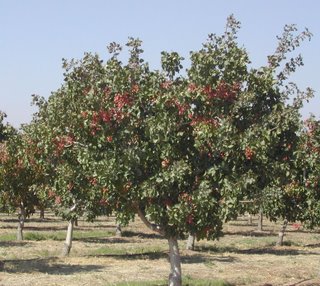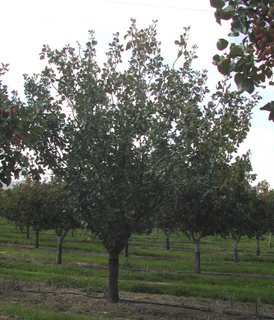 So I’ve been talking a lot about pistachios lately. And anyone who has stopped by our house recently has probably tasted my pistachio clusters, pistachio macaroons, pistachio cranberry oatmeal cookies, or pistachio raspberry cake. Hmm, notice a common thread here?
So I’ve been talking a lot about pistachios lately. And anyone who has stopped by our house recently has probably tasted my pistachio clusters, pistachio macaroons, pistachio cranberry oatmeal cookies, or pistachio raspberry cake. Hmm, notice a common thread here?
I finally have the perfect job. I get to write about food AND bake up new recipes. I think this must be heaven.
Not all of you know that I didn’t actually go to France to take the professional baking program I’d signed up for. That’s the bad news. The good news is that I was here for the pistachio harvest in Cuyama (the northeast part of Santa Barbara County).
Dave and I drove to the Santa Barbara Pistachio farm in Cuyama last week. A beautiful trip out highway 33 past amazing geological rock formations and sedimentary deposits turned on their sides. (Next time I’ll take some pictures of those.)
We arrived at the store and found Gail back in the processing and shipping area behind the store.
 We’d guessed that we were getting close to the store when we started seeing these trees at the side of the road. Pistachios grow in red clusters on the female trees. Most of the trees in the orchard are female trees. These are young trees. It takes a tree about 1o years to develop and begin to produce a significant crop of pistachios.
We’d guessed that we were getting close to the store when we started seeing these trees at the side of the road. Pistachios grow in red clusters on the female trees. Most of the trees in the orchard are female trees. These are young trees. It takes a tree about 1o years to develop and begin to produce a significant crop of pistachios.
Pistachios originated in the high deserts of the Middle East. Iran is the world’s largest producer of pistachios, but California has also become a primary worldwide pistachio source. Cuyama’s growing conditions are quite similiar to the pistachio growing areas of Iran, Turkey, and Afghanistan.

There are also male trees in the orchard, but not nearly as many. They produce the pollen to fertilize the female flowers but don’t produce any pistachios. Wind carries the pollen to the female trees and one male can pollinate a LOT of female trees. So occasionally you’ll see a slightly larger fruitless tree surrounded by many fruit-laden trees. We can draw many conclusions about nature from this, but we won’t.
 And here are the progeny. The pistachios hang down in clusters, like grapes. On the outside is a lovely red fruity husk. You peel that off and inside is the hard shelled nut we recognize as a pistachio. The trick is to try to leave the clusters on the trees long enough for most of the shells to crack open inside the husks (called open shell pistachios). Many pistachios are harvested earlier and then the ends are cracked open artifically. Those nuts aren’t as rich and delicious as tree-ripened nuts, but the farmers don’t risk loss from rain or wind which can cause the tree to drop its ripest nuts before the harvest.
And here are the progeny. The pistachios hang down in clusters, like grapes. On the outside is a lovely red fruity husk. You peel that off and inside is the hard shelled nut we recognize as a pistachio. The trick is to try to leave the clusters on the trees long enough for most of the shells to crack open inside the husks (called open shell pistachios). Many pistachios are harvested earlier and then the ends are cracked open artifically. Those nuts aren’t as rich and delicious as tree-ripened nuts, but the farmers don’t risk loss from rain or wind which can cause the tree to drop its ripest nuts before the harvest.
Fortuntely the weather held and resulting nuts were definitely worth taking the risk.
